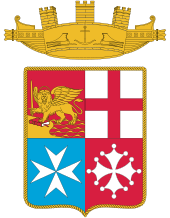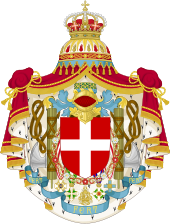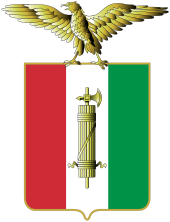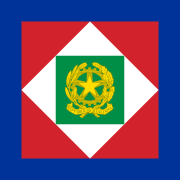Emblem of Italy
| Emblem of the Italian Republic | ||
|---|---|---|
Shield Upon a cogwheel proper, the Stella d'Italia ("Star of Italy") | | |
| Supporters | Olive and oak | |
| Motto | REPVBBLICA ITALIANA[a] | |
The emblem of the Italian Republic (
The emblem, shaped as a
The armorial bearings of the
Description


The central element of the emblem is the
The star marked the first award of Republican reconstruction, the
On the republican emblem, the Star of Italy is superimposed on a steel
Italy is a democratic republic, built on labour. Sovereignty belongs to the people, who exercise it in the forms and within the limits of the Constitution [...]

However, this reference to labour is not to be understood as a legal rule, which would oblige the State to protect it in detail, but rather to refer to the principle connected to it, which is the foundation of Italian society.[5] The second paragraph, instead, assigning sovereignty exclusively to the people, establishes the democratic character of the republic.[6] The cogwheel is also present on the flag and emblem of Angola and on the emblem of Mozambique, nations left by the process of decolonization of the Portuguese Empire[7][8] as well as on the coat of arms of the Italian municipalities of Assago, Cafasse and Chiesina Uzzanese.
The set formed by the cogwheel and the star of Italy is enclosed by an oak branch, located on the right, which symbolizes the strength and dignity of the Italians (in Latin the term robur means both oak and moral strength and physics,[9]) and from an olive branch, located instead on the left, which represents Italy's will for peace, both internally and vis-à-vis other nations.[4] Both oak and olive trees are characteristic of the Italian landscape. The green branches are in turn bound together by a red ribbon bearing the inscription REPVBBLICA ITALIANA in white capital letters. As regards Italy's desire for peace, Article 11 of the Constitution states:[10]
Italy rejects war as an instrument of offense against the freedom of other peoples and as a means of resolving international disputes; allows equal conditions with other states to the limitations of sovereignty necessary for an order that ensures peace and justice between nations; promotes and favors international organizations aimed at this purpose [...]
The refusal of war as an instrument of offense does not signify that Italy cannot participate in a conflict, instead that articles 78 and 87 of the Constitution prescribe which state organs decide the state of war.[5] In particular, for Italy, it is the two chambers that decree the state of war, which is then formally declared by the President of the Republic; the chambers then give the Italian government the necessary powers to face the conflict.[11] Another extraordinary provision in case of war is the duration of the legislature of the two chambers, which can be exceptionally extended, as stated in article 103 of the Constitution, beyond the five canonical years.[11]
The emblem of the Italian Republic is not defined as a coat of arms as it has no shield; the latter being in fact, according to the heraldic definition, an essential part of such devices (as opposed to other decorations such as, for example, crowns, helmets or fronds, which are accessory parts). For this reason, it is more correct to refer to it as a "national emblem".[12]
Armed forces

The Italian naval
To acknowledge the Navy's origins in ancient Rome, the rostrata crown, "... emblem of honor and of value that the Roman Senate conferred on duci of shipping companies, conquerors of lands and cities overseas," was proposed by Admiral Cavagnari in 1939. An inescutcheon, bearing the Savoy shield flanked by fasces, was removed before the arms were first employed.[14]
The
History

Kingdom of Italy (Napoleonic)
The


Kingdom of Italy
Between 1848 and 1861, a sequence of events led to the independence and unification of Italy (except for
The

On 4 May 1870, nine years later, the Consulta Araldica issued a decree on the arms, as with the Sardinian arms, two lions rampant in gold supporting the shield, bearing instead only the Savoy cross (as on the flag) now representing all Italy, with a crowned helmet, around which, the collars of the Military Order of Savoy, the Civil Order of Savoy, the Order of the Crown of Italy (established 2 February 1868), the Order of Saints Maurice and Lazarus, and the Supreme Order of the Most Holy Annunciation (bearing the motto FERT) were suspended. The lions held lances flying the national flag. From the helmet fell a royal mantle, engulfed by a pavilion under the Stellone d'Italia, purported to protect the nation.[18]
After twenty years, on 1 January 1890, the arms' exterior were slightly modified more in keeping with those of Sardinia. The fur mantling and lances disappeared and the crown was taken from the helmet to the pavilion, now sewn with crosses and roses. The
On 11 April 1929, the Savoy lions were replaced by Mussolini with

Italian Social Republic
The arms of the short-lived Nazi puppet state in northern Italy, the Repubblica Sociale Italiana (
This shield had previously been displayed alongside the Royal arms from 1927 to 1929, when the latter was modified to incorporate elements of both.[23]
On 25 April 1945, commemorated as Festa della Liberazione, the government of Benito Mussolini fell. The separate Italian Social Republic had existed for slightly more than one and a half years.
Italian Republic
The decision to provide the new Italian Republic with an emblem was taken by the government of Alcide De Gasperi in October 1946. The design was chosen by public competition, with the requirement that political party emblems were forbidden and the inclusion of the Stellone d'Italia (English: "Great Star of Italy"), "inspired by a sense of the earth and municipalities." The five winners were assigned further requirements for the design of the emblem, "a ring that has towered shaped crown," surrounded by a garland of Italian foliage and flora.

Below a representation of the sea, and above, the gold star, with the legend Unità e Libertà or Unity and Liberty in the
Gallery
-
Emblem rendered in black and white (with striped backgrounds)
-
Presidential standard of Italy (since 2000)
-
Standard of the deputy president of the Italian Republic (since 1986)
-
Standard of thepresident of the Council of Ministers of the Italian Republic(since 2008)
-
Standard of the civil authorities
-
Emblem on government letterhead
-
Emblem on an Italian passport
-
European Health Insurance Card issued in Italy showing the emblem
See also
- Armorial of Italy
- Coat of arms of Napoleonic Italy
- Il Canto degli Italiani
- National symbols of Italy
- Stella d'Italia
Notes
- ^ a b Repubblica Italiana is Italian for "Italian Republic", with the U – absent from the classical Latin alphabet – spelt with a V, as is common in inscriptions and heraldry.
Citations
- ^ a b c Rossi 2014, p. 38.
- ^ Bazzano 2011, p. 101.
- ^ cfr. Cesare Ripa, Iconologia, sec. XVI
- ^ a b "I simboli della Repubblica – L'emblema" (in Italian). Retrieved 10 October 2019.
- ^ a b c Villa 2010, p. 137.
- ^ Villa 2010, pp. 137–138.
- ^ "Bandiere". Retrieved 12 April 2017.
- ^ "Bandiere". Retrieved 12 April 2017.
- ^ Villa 2010, p. 139.
- ^ Villa 2010, p. 138.
- ^ a b "Costituzione della Repubblica Italiana" (PDF) (in Italian). Retrieved 11 April 2017.
- ^ "E l'astro del mattino diventò lo stellone d'Italia" (in Italian). Archived from the original on 1 July 2012.
- ^ Decreto Legislativo del capo provvisorio dello stato n. 1305 del 9 novembre 1947 (GU 275 del 29 novembre 1947)
- ^ "Emblema di onore e di valore che il Senato romano conferiva ai duci di imprese navali, conquistatori di terre e città oltremare;" La Bandiera della Marina Militare Archived 2008-09-15 at the Wayback Machine Ministero della Difesa (retrieved 5 October 2008)
- JSTOR 1843352
- ^ "Per viemmeglio dimostrare con segni esteriori il sentimento dell'unione italiana vogliamo che le Nostre truppe ... portino lo scudo di Savoia sovrapposto alla bandiera tricolore italiana." See Lawrence, D.H. (ed. Philip Crumpton) Movements in European History (p. 230) Cambridge University Press, 1989 for an overview
- ^ Lo Statuto Albertino Art. 77, dato in Torino addì quattro del mese di marzo l'anno del Signore mille ottocento quarantotto, e del Regno Nostro il decimo ottavo
- ^ Deliberazione della Consulta Araldica del Regno d’Italia con cui si determina quali debbano essere gli ornamenti esteriori dello stemma dello Stato Archived 2007-09-09 at the Wayback Machine, 4 maggio 1870; Regio Decreto n. 7282 del 27 novembre 1890
- ^ Armi della Real Casa d'Italia Archived 2011-07-18 at the Wayback Machine Corpo della Nobiltà Italiana; Gli stemmi della Famiglia Reale sono regolati dal relativo Regio Decreto del 1 gennaio 1890 e gli stemmi dello Stato e delle Amministrazioni governative sono regolati dal Regio Decreto del 27 novembre 1890
- ^ Compiti, Prerogative e Responsabilità del Capo di Casa Savoia nell'Italia Repubblicana Archived 2012-02-14 at the Wayback Machine Reale Casa d'Italia (retrieved 24 January 2009)
- ^ Regio Decreto n. 504 del 11 aprile 1929 VII
- ^ Foggia della bandiera nazionale e della bandiera di combattimento delle Forze Armate Decreto Legislativo del Duce della Repubblica Sociale Italiana e Capo del Governo n. 141 del 28 gennaio 1944 XXII EF (GU 107 del 6 maggio 1944 XXII EF)
- ^ Regio Decreto n. 2061 del 12 dicembre 1926 sull'emblema del Fascio Littorio, Regio Decreto Legislativo n. 2273 del 30 dicembre 1926 norme per la fabbricazione, distribuzione e vendita di insegne e distintivi portanti l'emblema del Fascio Littorio, Regio Decreto n. 1048 del 27 marzo 1927 disposizioni circa l'uso del Fascio Littorio da parte delle Amministrazioni dello Stato, Legge n. 928 del 9 giugno 1927 conversione in legge del R. D.-L. 12 dicembre 1926, che dichiara il Fascio Littorio emblema dello Stato (GU 160 del 13 luglio 1927)
- ^ Foggia ed uso dell'emblema dello Stato Decreto Legislativo n. 535 del 5 maggio 1948, pubblicato nella Gazzetta Ufficiale n. 122 del 28 maggio 1948 suppl. ord.
- ^ Decreto Legislativo n. 535 del 5 maggio 1948 infoleges.it
References
- Bazzano, Nicoletta (2011). Donna Italia. L'allegoria della Penisola dall'antichità ai giorni nostri (in Italian). Angelo Colla Editore. ISBN 978-88-96817-06-3.
- Rossi, Girolamo (2014). Lo scudo crociato. Un simbolo medievale nella comunicazione politica del Novecento (in Italian). Armando Editore. ISBN 978-88-96817-06-3.
- Villa, Claudio (2010). I simboli della Repubblica: la bandiera tricolore, il canto degli italiani, l'emblema (in Italian). Comune di Vanzago. SBN IT\ICCU\LO1\1355389.
External links
 Media related to Emblem of Italy at Wikimedia Commons
Media related to Emblem of Italy at Wikimedia Commons- Un simbolo per la Repubblica Presidenza della Repubblica, Palazzo del Quirinale (in Italian)
- Italian Civic Heraldry International Civic Heraldry, Ralf Hartemink (in English) (archived 3 June 2009)








